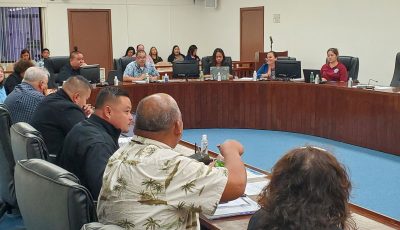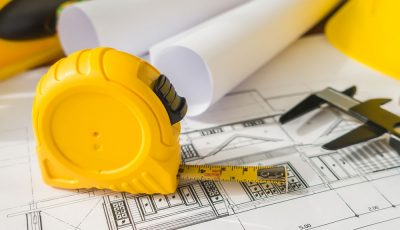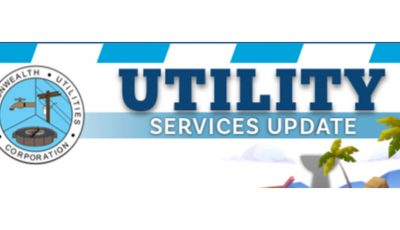PSS announces start of schools on Saipan
50 buildings damaged; ‘half-day’ sessions planned
When Garapan Elementary School teacher Peter Loken arrived back on island after vacation last weekend, he saw a “new island.”
Loken is one of the many Public School System teachers and staff who reported to work for their first day back at school after Typhoon Soudelor left Saipan in a state of disaster.

Education Commissioner Dr. Rita Sablan shows off one of the damaged classrooms at the Garapan Elementary School. (Dennis B. Chan)
“Trying to get back into a routine—or some normalcy—when’s it’s totally not like it is, is going to be a challenge for most students,” Loken said.
PSS announced yesterday that they have scheduled Head Start and elementary schools on Saipan to begin classes on Sep. 14.
For middle, junior, and high schools on island, classes will begin on Sep. 8.
Education Commissioner Dr. Rita Sablan spoke to reporters at the Garapan school campus yesterday, showing examples of the damage Soudelor left.
Because of the difficulties with no power and water, every single school on Saipan will hold half-day sessions, the commissioner said. Garapan and San Vicente elementary schools will hold “double-sessions” of half-day classes.
“We are going to have half-day sessions only until water and power is full restored,” Sablan said.
PSS has water tanks at every school campus that will be filled with potable water on a regular basis for use in restrooms.
PSS expects a difficult year without electric power. They are advising all teachers to open windows and doors to circulate air in the classroom and have natural lighting.
Sablan said they are getting teachers prepared for the conditions they are going to be facing when they start instruction in a couple of weeks.
“I know it’s going to be very difficult year,” Sablan said. “We are preparing them for what to anticipate in terms of students who are coming to school without power or water or home.”
PSS recently has placed an emphasis on technology in classrooms, but without power teachers will have to go back to the drawing board, literally.
But technology is not just computers, Sablan said. It is anything students can use to facilitate their education.
PSS plans for breakfast and lunch for students and transportation will be scheduled as normal.
Garapan Elementary School and San Vicente Elementary School will have “double-sessions” this year, splitting their days between kindergarten to second grade classes in the morning, and third to fifth grade classes in the afternoon.
PSS expects new teachers, and counselors. It’s still unclear how student enrollment figures have been affected. Sablan said the schools were still trying to get their student enrollment together.
PSS recruited about 15 to 20 off-island teachers for this school year
PSS schools have had as high as 12,000 and 11,000 students. Last year, they had 10,300 students. The commissioner said if they do have additional students, their capacity could go as high as 12,000.
Public school damage
PSS is preparing a “public assistance” package for Federal Emergency Management Agency to help with damage from Typhoon Soudelor.
A project specialist from FEMA was on-site yesterday doing her assessment of damage that occurred at the Garapan school.
Sablan told Saipan Tribune they expect damage costs to “run in the millions.”
“We are going to start doing cost-estimates right now,” adding that engineers are helping with this estimate.
“The scope of work is not going to be simple,” she said.
Buildings A, B, and C at Garapan Elementary incurred the worst damage. That’s one reason why GES is going into double session.
GES has a total of 14 classrooms that will not be available next school year, she said.
San Vicente has 20 to 24 damaged classrooms that need restoration.
They are the some of the largest schools in the CNMI.
“We want to make sure they are safe before we reopen them. It needs reconstruction, meaning they have to tear down parts of the roof to replace what’s broken,” Sablan said.
PSS is also asking for 22 generators from the local government, according to Sablan.
She said every school has a generator, but they aim for spare ones.
Sablan led reporters around GES yesterday. Once classroom had one part of its roof torn out. A bed of stagnant water collected on the classroom’s floor. Computers and instructional materials were rained out.
Loken, who is also the 2013 CNMI State Teacher of the Year, said the island still has a “long way to go” to full recovery.
“I think the biggest thing will be to collaborate with our teachers, because we’ll be sharing rooms and different grades in there. How do you get a 6th grader in a first grader’s desk is one problem they have to solve, he said.
“We are trying to come up with creative solutions,” he said.
Speaking of possible trauma students may have experienced from the typhoon, Sablan said PSS counselors will be connecting with local stakeholders and social services so that not only children but faculty and staff are given support.
“Families…are still living in tents, or partially broken homes. They are trying to make do with what they have,” she said.
“Whether they know about ancient China or Greece is probably not a huge important topic this year. It’s going to be about making sure everybody is healthy and safe, not just here but also at their homes too,” Loken said.



























